Analysis of Coca-Cola's International Brand Management Strategies
VerifiedAdded on 2022/11/17
|12
|2914
|314
Report
AI Summary
This report provides a comprehensive analysis of The Coca-Cola Company's international brand management, focusing on the factors that affect its global operations. The report begins with an executive summary and an introduction to Coca-Cola's global presence and market position. It then delves into a detailed PESTLE analysis, examining the political, economic, socio-cultural, technological, environmental, and legal factors influencing the company. Following the external environment assessment, a SWOT analysis identifies Coca-Cola's strengths, weaknesses, opportunities, and threats. The report highlights the company's valuable brand, extensive distribution network, and market share as strengths, while acknowledging water scarcity and health concerns as weaknesses. It explores opportunities for product innovation and market expansion, while also addressing competitive threats and changing consumer preferences. Finally, the report evaluates Coca-Cola's 'one brand strategy' and concludes with a strategic plan to manage internal and external factors effectively. The report is a valuable resource for understanding the complexities of managing an international brand in a dynamic global environment.
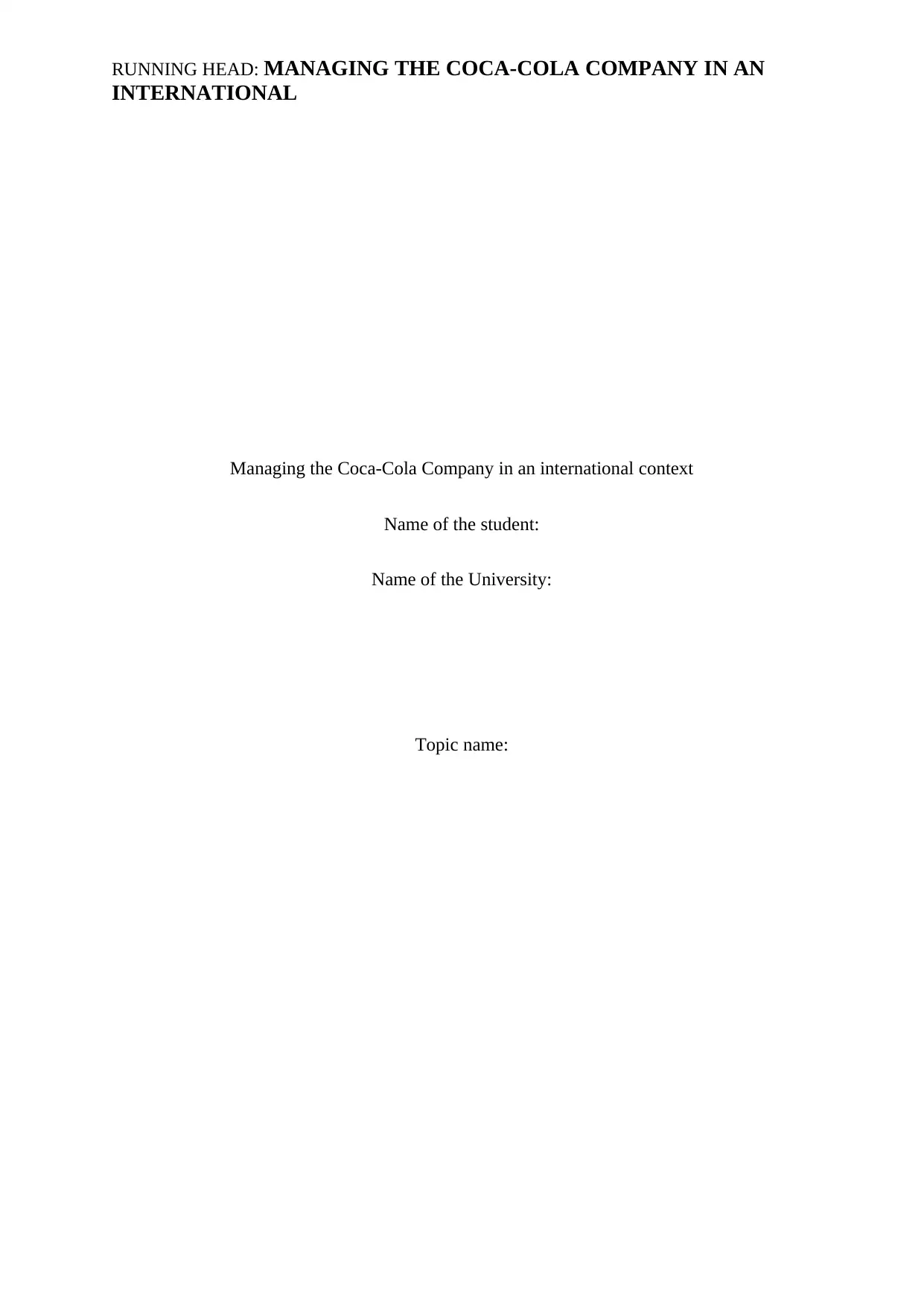
RUNNING HEAD: MANAGING THE COCA-COLA COMPANY IN AN
INTERNATIONAL
Managing the Coca-Cola Company in an international context
Name of the student:
Name of the University:
Topic name:
INTERNATIONAL
Managing the Coca-Cola Company in an international context
Name of the student:
Name of the University:
Topic name:
Paraphrase This Document
Need a fresh take? Get an instant paraphrase of this document with our AI Paraphraser
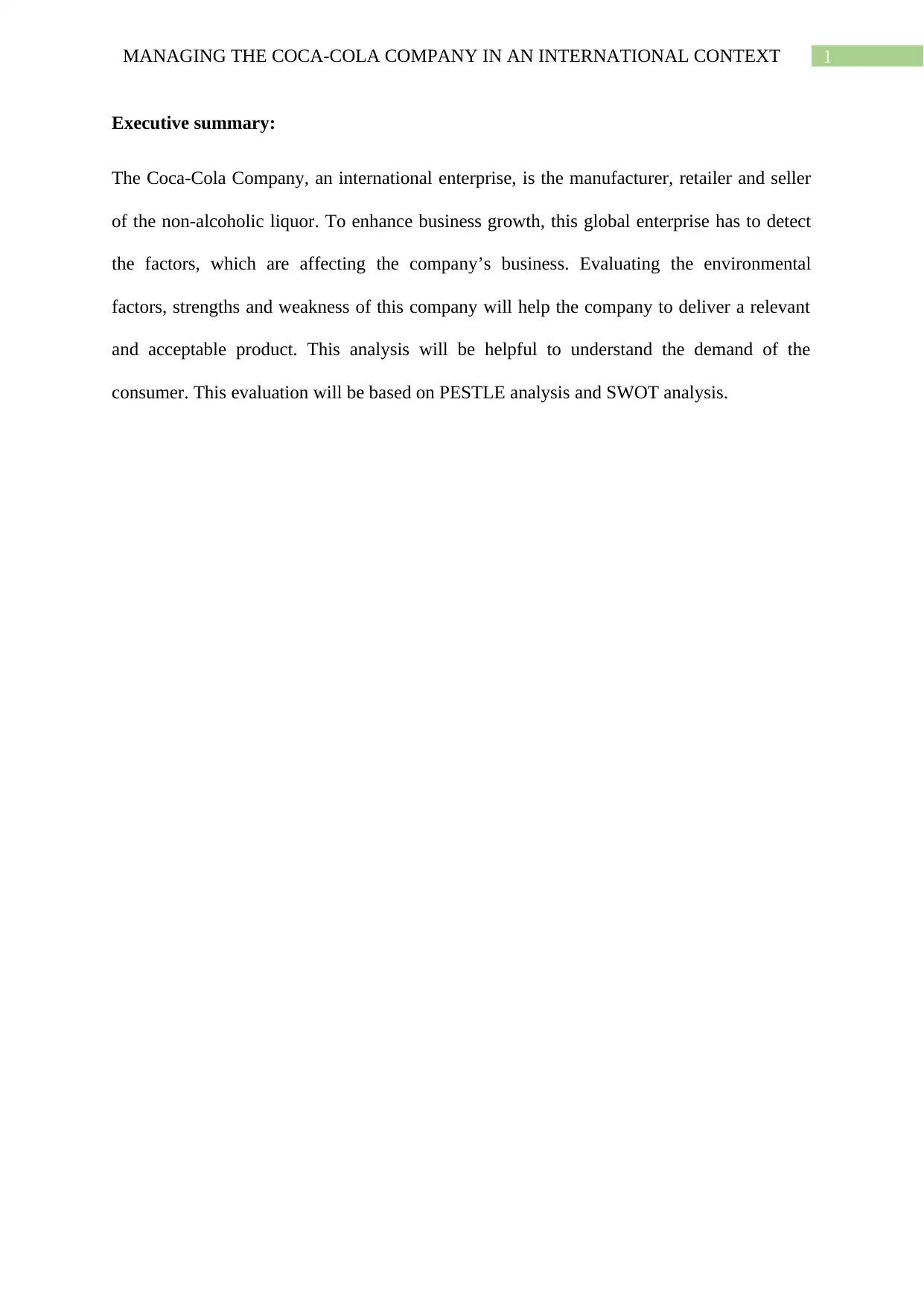
1MANAGING THE COCA-COLA COMPANY IN AN INTERNATIONAL CONTEXT
Executive summary:
The Coca-Cola Company, an international enterprise, is the manufacturer, retailer and seller
of the non-alcoholic liquor. To enhance business growth, this global enterprise has to detect
the factors, which are affecting the company’s business. Evaluating the environmental
factors, strengths and weakness of this company will help the company to deliver a relevant
and acceptable product. This analysis will be helpful to understand the demand of the
consumer. This evaluation will be based on PESTLE analysis and SWOT analysis.
Executive summary:
The Coca-Cola Company, an international enterprise, is the manufacturer, retailer and seller
of the non-alcoholic liquor. To enhance business growth, this global enterprise has to detect
the factors, which are affecting the company’s business. Evaluating the environmental
factors, strengths and weakness of this company will help the company to deliver a relevant
and acceptable product. This analysis will be helpful to understand the demand of the
consumer. This evaluation will be based on PESTLE analysis and SWOT analysis.
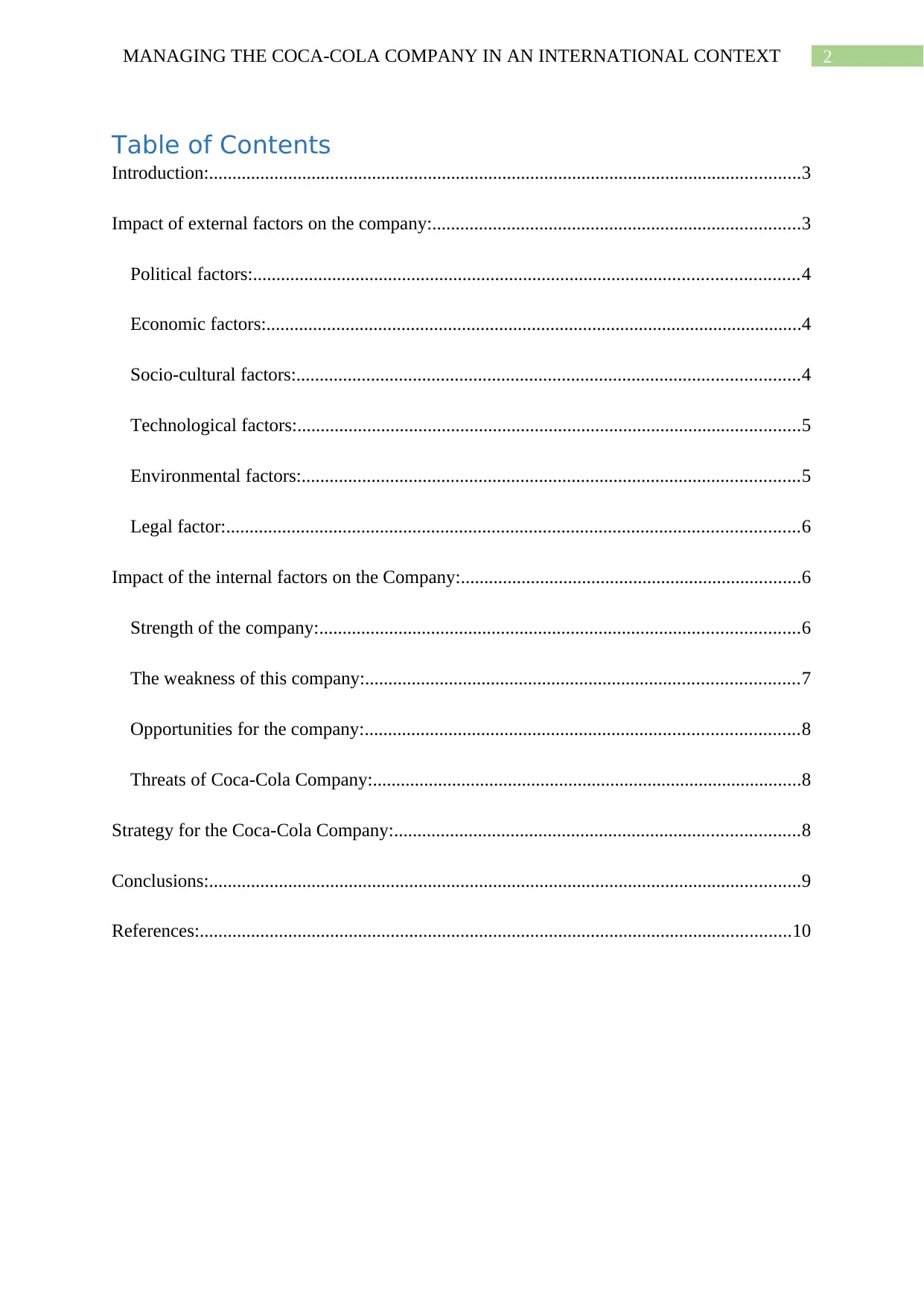
2MANAGING THE COCA-COLA COMPANY IN AN INTERNATIONAL CONTEXT
Table of Contents
Introduction:...............................................................................................................................3
Impact of external factors on the company:...............................................................................3
Political factors:.....................................................................................................................4
Economic factors:...................................................................................................................4
Socio-cultural factors:............................................................................................................4
Technological factors:............................................................................................................5
Environmental factors:...........................................................................................................5
Legal factor:...........................................................................................................................6
Impact of the internal factors on the Company:.........................................................................6
Strength of the company:.......................................................................................................6
The weakness of this company:.............................................................................................7
Opportunities for the company:.............................................................................................8
Threats of Coca-Cola Company:............................................................................................8
Strategy for the Coca-Cola Company:.......................................................................................8
Conclusions:...............................................................................................................................9
References:...............................................................................................................................10
Table of Contents
Introduction:...............................................................................................................................3
Impact of external factors on the company:...............................................................................3
Political factors:.....................................................................................................................4
Economic factors:...................................................................................................................4
Socio-cultural factors:............................................................................................................4
Technological factors:............................................................................................................5
Environmental factors:...........................................................................................................5
Legal factor:...........................................................................................................................6
Impact of the internal factors on the Company:.........................................................................6
Strength of the company:.......................................................................................................6
The weakness of this company:.............................................................................................7
Opportunities for the company:.............................................................................................8
Threats of Coca-Cola Company:............................................................................................8
Strategy for the Coca-Cola Company:.......................................................................................8
Conclusions:...............................................................................................................................9
References:...............................................................................................................................10
⊘ This is a preview!⊘
Do you want full access?
Subscribe today to unlock all pages.

Trusted by 1+ million students worldwide
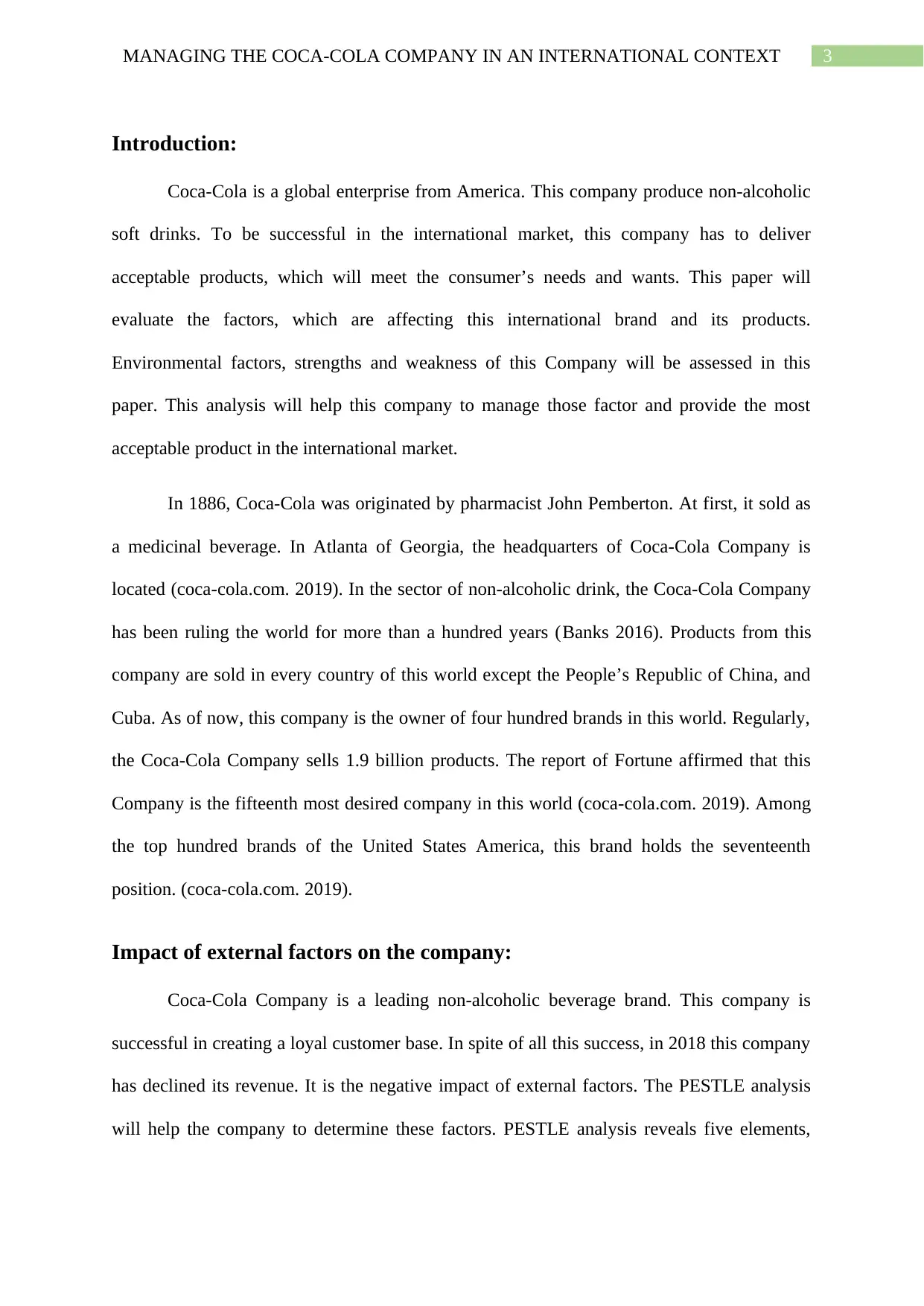
3MANAGING THE COCA-COLA COMPANY IN AN INTERNATIONAL CONTEXT
Introduction:
Coca-Cola is a global enterprise from America. This company produce non-alcoholic
soft drinks. To be successful in the international market, this company has to deliver
acceptable products, which will meet the consumer’s needs and wants. This paper will
evaluate the factors, which are affecting this international brand and its products.
Environmental factors, strengths and weakness of this Company will be assessed in this
paper. This analysis will help this company to manage those factor and provide the most
acceptable product in the international market.
In 1886, Coca-Cola was originated by pharmacist John Pemberton. At first, it sold as
a medicinal beverage. In Atlanta of Georgia, the headquarters of Coca-Cola Company is
located (coca-cola.com. 2019). In the sector of non-alcoholic drink, the Coca-Cola Company
has been ruling the world for more than a hundred years (Banks 2016). Products from this
company are sold in every country of this world except the People’s Republic of China, and
Cuba. As of now, this company is the owner of four hundred brands in this world. Regularly,
the Coca-Cola Company sells 1.9 billion products. The report of Fortune affirmed that this
Company is the fifteenth most desired company in this world (coca-cola.com. 2019). Among
the top hundred brands of the United States America, this brand holds the seventeenth
position. (coca-cola.com. 2019).
Impact of external factors on the company:
Coca-Cola Company is a leading non-alcoholic beverage brand. This company is
successful in creating a loyal customer base. In spite of all this success, in 2018 this company
has declined its revenue. It is the negative impact of external factors. The PESTLE analysis
will help the company to determine these factors. PESTLE analysis reveals five elements,
Introduction:
Coca-Cola is a global enterprise from America. This company produce non-alcoholic
soft drinks. To be successful in the international market, this company has to deliver
acceptable products, which will meet the consumer’s needs and wants. This paper will
evaluate the factors, which are affecting this international brand and its products.
Environmental factors, strengths and weakness of this Company will be assessed in this
paper. This analysis will help this company to manage those factor and provide the most
acceptable product in the international market.
In 1886, Coca-Cola was originated by pharmacist John Pemberton. At first, it sold as
a medicinal beverage. In Atlanta of Georgia, the headquarters of Coca-Cola Company is
located (coca-cola.com. 2019). In the sector of non-alcoholic drink, the Coca-Cola Company
has been ruling the world for more than a hundred years (Banks 2016). Products from this
company are sold in every country of this world except the People’s Republic of China, and
Cuba. As of now, this company is the owner of four hundred brands in this world. Regularly,
the Coca-Cola Company sells 1.9 billion products. The report of Fortune affirmed that this
Company is the fifteenth most desired company in this world (coca-cola.com. 2019). Among
the top hundred brands of the United States America, this brand holds the seventeenth
position. (coca-cola.com. 2019).
Impact of external factors on the company:
Coca-Cola Company is a leading non-alcoholic beverage brand. This company is
successful in creating a loyal customer base. In spite of all this success, in 2018 this company
has declined its revenue. It is the negative impact of external factors. The PESTLE analysis
will help the company to determine these factors. PESTLE analysis reveals five elements,
Paraphrase This Document
Need a fresh take? Get an instant paraphrase of this document with our AI Paraphraser
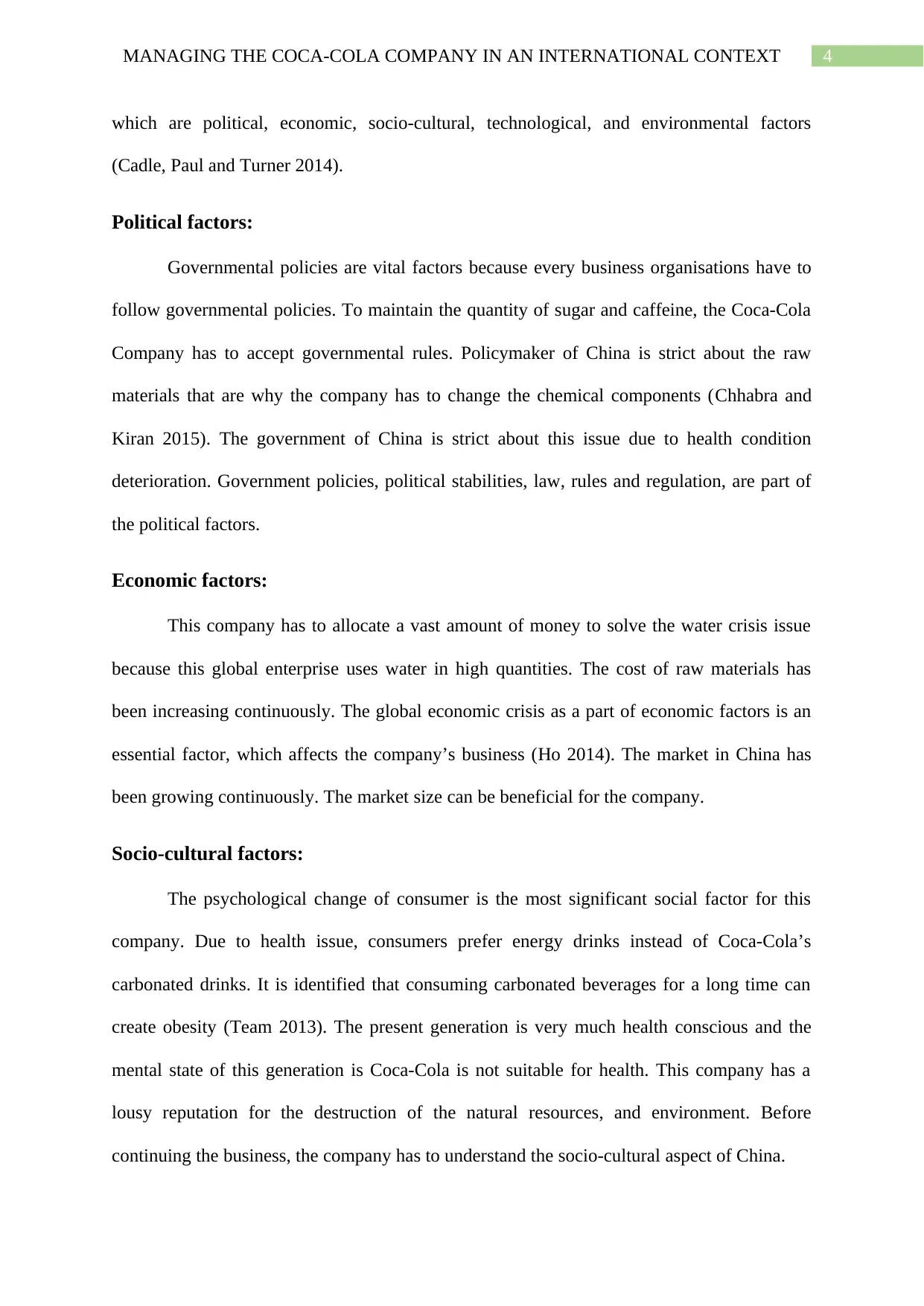
4MANAGING THE COCA-COLA COMPANY IN AN INTERNATIONAL CONTEXT
which are political, economic, socio-cultural, technological, and environmental factors
(Cadle, Paul and Turner 2014).
Political factors:
Governmental policies are vital factors because every business organisations have to
follow governmental policies. To maintain the quantity of sugar and caffeine, the Coca-Cola
Company has to accept governmental rules. Policymaker of China is strict about the raw
materials that are why the company has to change the chemical components (Chhabra and
Kiran 2015). The government of China is strict about this issue due to health condition
deterioration. Government policies, political stabilities, law, rules and regulation, are part of
the political factors.
Economic factors:
This company has to allocate a vast amount of money to solve the water crisis issue
because this global enterprise uses water in high quantities. The cost of raw materials has
been increasing continuously. The global economic crisis as a part of economic factors is an
essential factor, which affects the company’s business (Ho 2014). The market in China has
been growing continuously. The market size can be beneficial for the company.
Socio-cultural factors:
The psychological change of consumer is the most significant social factor for this
company. Due to health issue, consumers prefer energy drinks instead of Coca-Cola’s
carbonated drinks. It is identified that consuming carbonated beverages for a long time can
create obesity (Team 2013). The present generation is very much health conscious and the
mental state of this generation is Coca-Cola is not suitable for health. This company has a
lousy reputation for the destruction of the natural resources, and environment. Before
continuing the business, the company has to understand the socio-cultural aspect of China.
which are political, economic, socio-cultural, technological, and environmental factors
(Cadle, Paul and Turner 2014).
Political factors:
Governmental policies are vital factors because every business organisations have to
follow governmental policies. To maintain the quantity of sugar and caffeine, the Coca-Cola
Company has to accept governmental rules. Policymaker of China is strict about the raw
materials that are why the company has to change the chemical components (Chhabra and
Kiran 2015). The government of China is strict about this issue due to health condition
deterioration. Government policies, political stabilities, law, rules and regulation, are part of
the political factors.
Economic factors:
This company has to allocate a vast amount of money to solve the water crisis issue
because this global enterprise uses water in high quantities. The cost of raw materials has
been increasing continuously. The global economic crisis as a part of economic factors is an
essential factor, which affects the company’s business (Ho 2014). The market in China has
been growing continuously. The market size can be beneficial for the company.
Socio-cultural factors:
The psychological change of consumer is the most significant social factor for this
company. Due to health issue, consumers prefer energy drinks instead of Coca-Cola’s
carbonated drinks. It is identified that consuming carbonated beverages for a long time can
create obesity (Team 2013). The present generation is very much health conscious and the
mental state of this generation is Coca-Cola is not suitable for health. This company has a
lousy reputation for the destruction of the natural resources, and environment. Before
continuing the business, the company has to understand the socio-cultural aspect of China.
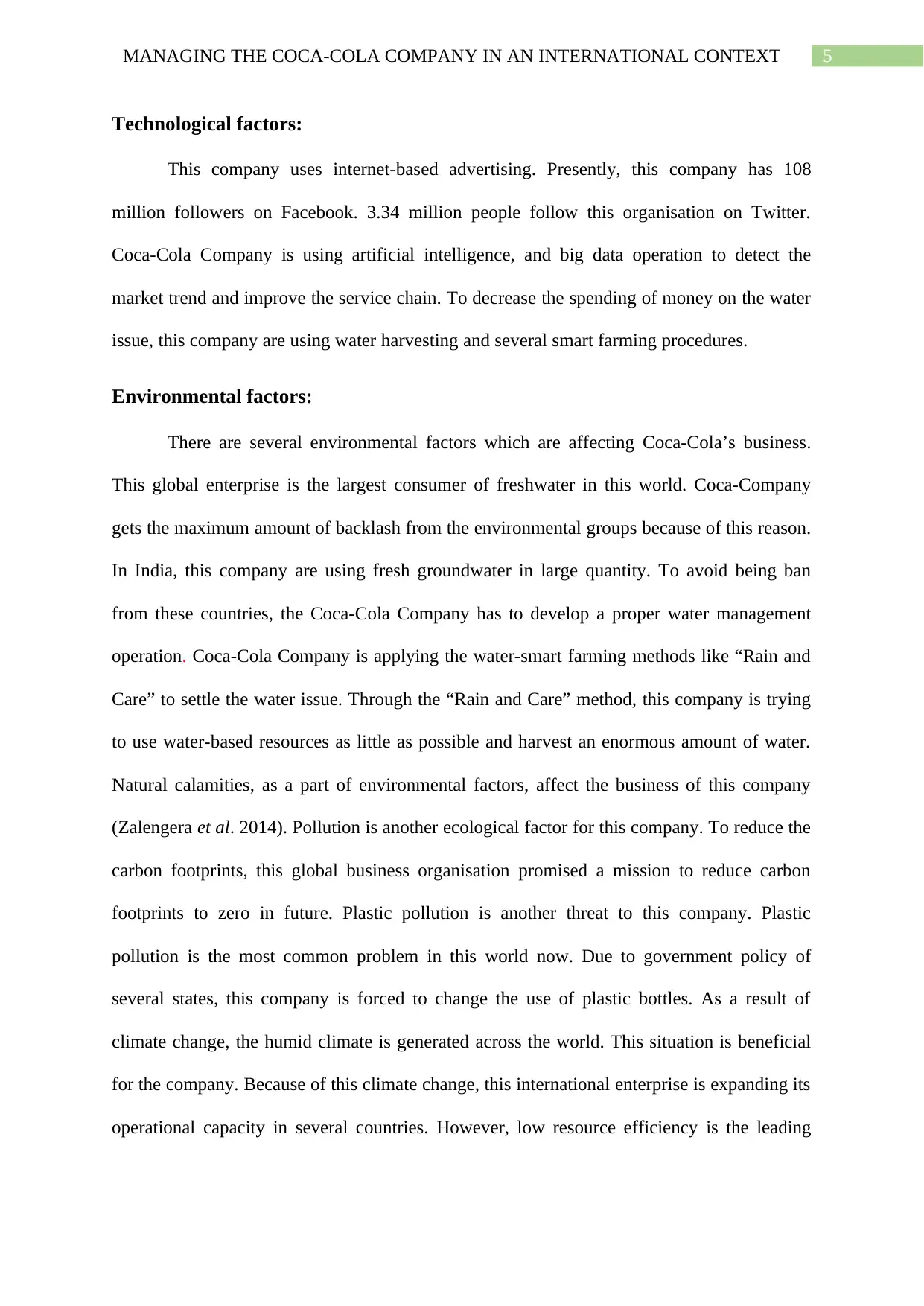
5MANAGING THE COCA-COLA COMPANY IN AN INTERNATIONAL CONTEXT
Technological factors:
This company uses internet-based advertising. Presently, this company has 108
million followers on Facebook. 3.34 million people follow this organisation on Twitter.
Coca-Cola Company is using artificial intelligence, and big data operation to detect the
market trend and improve the service chain. To decrease the spending of money on the water
issue, this company are using water harvesting and several smart farming procedures.
Environmental factors:
There are several environmental factors which are affecting Coca-Cola’s business.
This global enterprise is the largest consumer of freshwater in this world. Coca-Company
gets the maximum amount of backlash from the environmental groups because of this reason.
In India, this company are using fresh groundwater in large quantity. To avoid being ban
from these countries, the Coca-Cola Company has to develop a proper water management
operation. Coca-Cola Company is applying the water-smart farming methods like “Rain and
Care” to settle the water issue. Through the “Rain and Care” method, this company is trying
to use water-based resources as little as possible and harvest an enormous amount of water.
Natural calamities, as a part of environmental factors, affect the business of this company
(Zalengera et al. 2014). Pollution is another ecological factor for this company. To reduce the
carbon footprints, this global business organisation promised a mission to reduce carbon
footprints to zero in future. Plastic pollution is another threat to this company. Plastic
pollution is the most common problem in this world now. Due to government policy of
several states, this company is forced to change the use of plastic bottles. As a result of
climate change, the humid climate is generated across the world. This situation is beneficial
for the company. Because of this climate change, this international enterprise is expanding its
operational capacity in several countries. However, low resource efficiency is the leading
Technological factors:
This company uses internet-based advertising. Presently, this company has 108
million followers on Facebook. 3.34 million people follow this organisation on Twitter.
Coca-Cola Company is using artificial intelligence, and big data operation to detect the
market trend and improve the service chain. To decrease the spending of money on the water
issue, this company are using water harvesting and several smart farming procedures.
Environmental factors:
There are several environmental factors which are affecting Coca-Cola’s business.
This global enterprise is the largest consumer of freshwater in this world. Coca-Company
gets the maximum amount of backlash from the environmental groups because of this reason.
In India, this company are using fresh groundwater in large quantity. To avoid being ban
from these countries, the Coca-Cola Company has to develop a proper water management
operation. Coca-Cola Company is applying the water-smart farming methods like “Rain and
Care” to settle the water issue. Through the “Rain and Care” method, this company is trying
to use water-based resources as little as possible and harvest an enormous amount of water.
Natural calamities, as a part of environmental factors, affect the business of this company
(Zalengera et al. 2014). Pollution is another ecological factor for this company. To reduce the
carbon footprints, this global business organisation promised a mission to reduce carbon
footprints to zero in future. Plastic pollution is another threat to this company. Plastic
pollution is the most common problem in this world now. Due to government policy of
several states, this company is forced to change the use of plastic bottles. As a result of
climate change, the humid climate is generated across the world. This situation is beneficial
for the company. Because of this climate change, this international enterprise is expanding its
operational capacity in several countries. However, low resource efficiency is the leading
⊘ This is a preview!⊘
Do you want full access?
Subscribe today to unlock all pages.

Trusted by 1+ million students worldwide
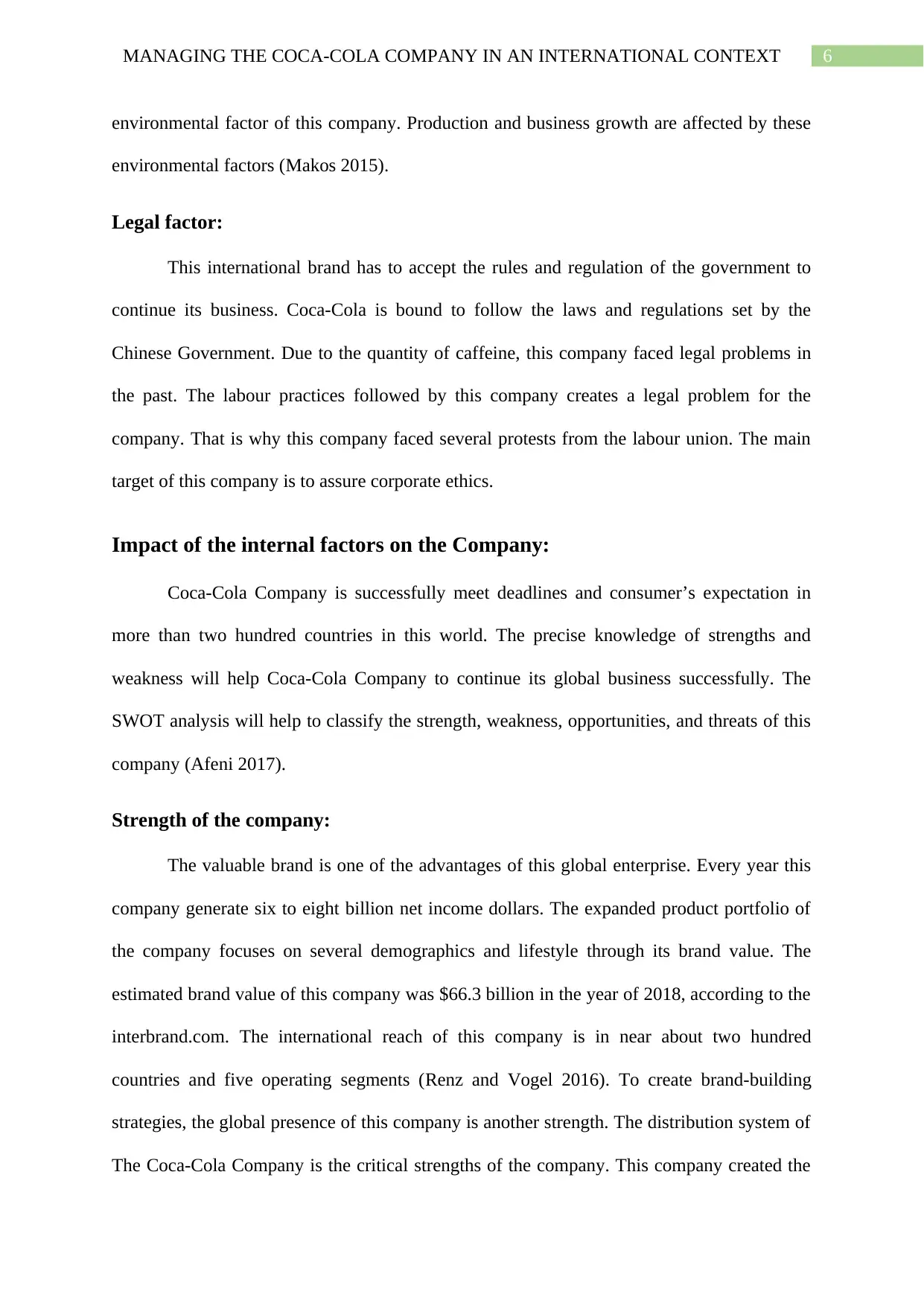
6MANAGING THE COCA-COLA COMPANY IN AN INTERNATIONAL CONTEXT
environmental factor of this company. Production and business growth are affected by these
environmental factors (Makos 2015).
Legal factor:
This international brand has to accept the rules and regulation of the government to
continue its business. Coca-Cola is bound to follow the laws and regulations set by the
Chinese Government. Due to the quantity of caffeine, this company faced legal problems in
the past. The labour practices followed by this company creates a legal problem for the
company. That is why this company faced several protests from the labour union. The main
target of this company is to assure corporate ethics.
Impact of the internal factors on the Company:
Coca-Cola Company is successfully meet deadlines and consumer’s expectation in
more than two hundred countries in this world. The precise knowledge of strengths and
weakness will help Coca-Cola Company to continue its global business successfully. The
SWOT analysis will help to classify the strength, weakness, opportunities, and threats of this
company (Afeni 2017).
Strength of the company:
The valuable brand is one of the advantages of this global enterprise. Every year this
company generate six to eight billion net income dollars. The expanded product portfolio of
the company focuses on several demographics and lifestyle through its brand value. The
estimated brand value of this company was $66.3 billion in the year of 2018, according to the
interbrand.com. The international reach of this company is in near about two hundred
countries and five operating segments (Renz and Vogel 2016). To create brand-building
strategies, the global presence of this company is another strength. The distribution system of
The Coca-Cola Company is the critical strengths of the company. This company created the
environmental factor of this company. Production and business growth are affected by these
environmental factors (Makos 2015).
Legal factor:
This international brand has to accept the rules and regulation of the government to
continue its business. Coca-Cola is bound to follow the laws and regulations set by the
Chinese Government. Due to the quantity of caffeine, this company faced legal problems in
the past. The labour practices followed by this company creates a legal problem for the
company. That is why this company faced several protests from the labour union. The main
target of this company is to assure corporate ethics.
Impact of the internal factors on the Company:
Coca-Cola Company is successfully meet deadlines and consumer’s expectation in
more than two hundred countries in this world. The precise knowledge of strengths and
weakness will help Coca-Cola Company to continue its global business successfully. The
SWOT analysis will help to classify the strength, weakness, opportunities, and threats of this
company (Afeni 2017).
Strength of the company:
The valuable brand is one of the advantages of this global enterprise. Every year this
company generate six to eight billion net income dollars. The expanded product portfolio of
the company focuses on several demographics and lifestyle through its brand value. The
estimated brand value of this company was $66.3 billion in the year of 2018, according to the
interbrand.com. The international reach of this company is in near about two hundred
countries and five operating segments (Renz and Vogel 2016). To create brand-building
strategies, the global presence of this company is another strength. The distribution system of
The Coca-Cola Company is the critical strengths of the company. This company created the
Paraphrase This Document
Need a fresh take? Get an instant paraphrase of this document with our AI Paraphraser
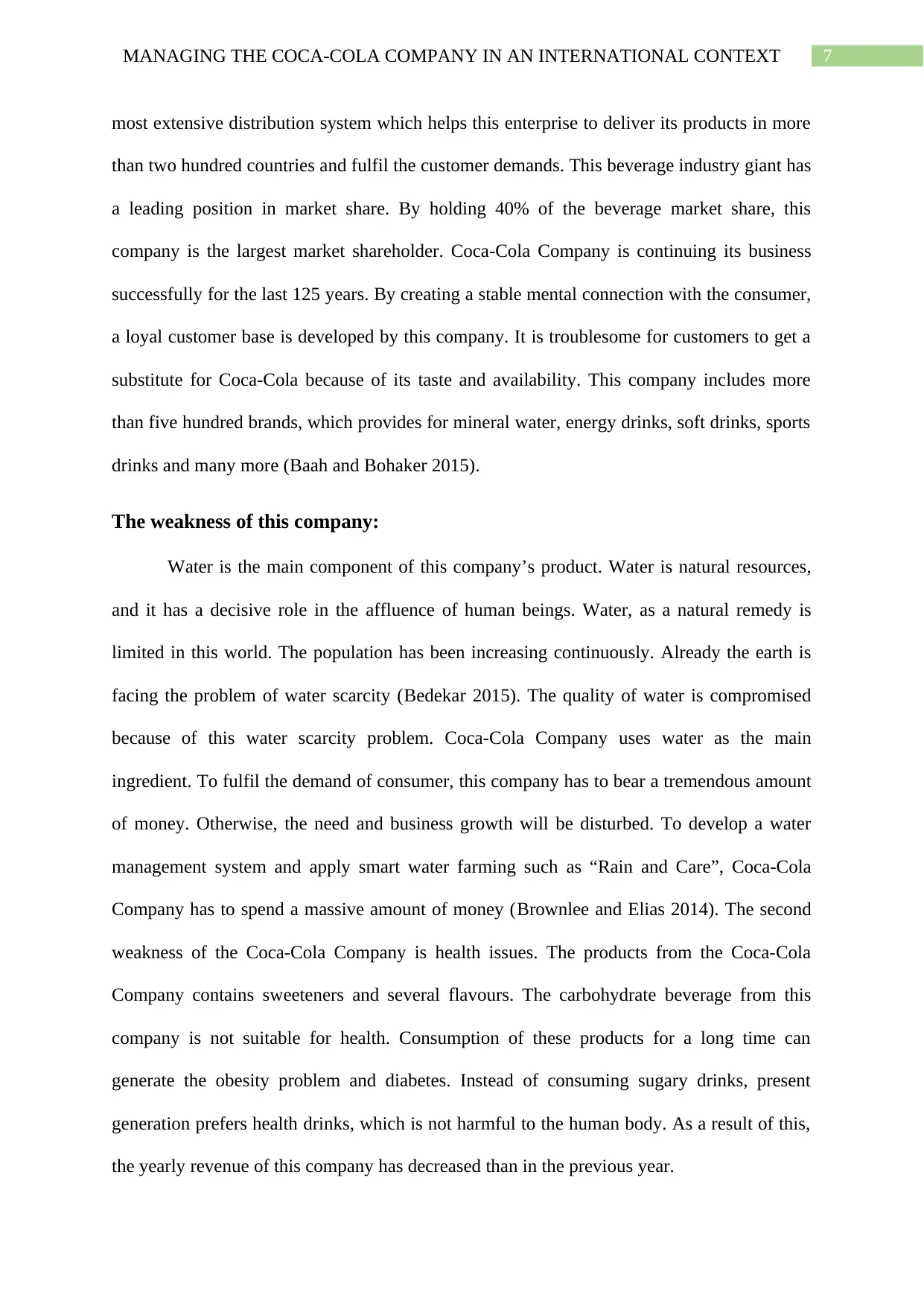
7MANAGING THE COCA-COLA COMPANY IN AN INTERNATIONAL CONTEXT
most extensive distribution system which helps this enterprise to deliver its products in more
than two hundred countries and fulfil the customer demands. This beverage industry giant has
a leading position in market share. By holding 40% of the beverage market share, this
company is the largest market shareholder. Coca-Cola Company is continuing its business
successfully for the last 125 years. By creating a stable mental connection with the consumer,
a loyal customer base is developed by this company. It is troublesome for customers to get a
substitute for Coca-Cola because of its taste and availability. This company includes more
than five hundred brands, which provides for mineral water, energy drinks, soft drinks, sports
drinks and many more (Baah and Bohaker 2015).
The weakness of this company:
Water is the main component of this company’s product. Water is natural resources,
and it has a decisive role in the affluence of human beings. Water, as a natural remedy is
limited in this world. The population has been increasing continuously. Already the earth is
facing the problem of water scarcity (Bedekar 2015). The quality of water is compromised
because of this water scarcity problem. Coca-Cola Company uses water as the main
ingredient. To fulfil the demand of consumer, this company has to bear a tremendous amount
of money. Otherwise, the need and business growth will be disturbed. To develop a water
management system and apply smart water farming such as “Rain and Care”, Coca-Cola
Company has to spend a massive amount of money (Brownlee and Elias 2014). The second
weakness of the Coca-Cola Company is health issues. The products from the Coca-Cola
Company contains sweeteners and several flavours. The carbohydrate beverage from this
company is not suitable for health. Consumption of these products for a long time can
generate the obesity problem and diabetes. Instead of consuming sugary drinks, present
generation prefers health drinks, which is not harmful to the human body. As a result of this,
the yearly revenue of this company has decreased than in the previous year.
most extensive distribution system which helps this enterprise to deliver its products in more
than two hundred countries and fulfil the customer demands. This beverage industry giant has
a leading position in market share. By holding 40% of the beverage market share, this
company is the largest market shareholder. Coca-Cola Company is continuing its business
successfully for the last 125 years. By creating a stable mental connection with the consumer,
a loyal customer base is developed by this company. It is troublesome for customers to get a
substitute for Coca-Cola because of its taste and availability. This company includes more
than five hundred brands, which provides for mineral water, energy drinks, soft drinks, sports
drinks and many more (Baah and Bohaker 2015).
The weakness of this company:
Water is the main component of this company’s product. Water is natural resources,
and it has a decisive role in the affluence of human beings. Water, as a natural remedy is
limited in this world. The population has been increasing continuously. Already the earth is
facing the problem of water scarcity (Bedekar 2015). The quality of water is compromised
because of this water scarcity problem. Coca-Cola Company uses water as the main
ingredient. To fulfil the demand of consumer, this company has to bear a tremendous amount
of money. Otherwise, the need and business growth will be disturbed. To develop a water
management system and apply smart water farming such as “Rain and Care”, Coca-Cola
Company has to spend a massive amount of money (Brownlee and Elias 2014). The second
weakness of the Coca-Cola Company is health issues. The products from the Coca-Cola
Company contains sweeteners and several flavours. The carbohydrate beverage from this
company is not suitable for health. Consumption of these products for a long time can
generate the obesity problem and diabetes. Instead of consuming sugary drinks, present
generation prefers health drinks, which is not harmful to the human body. As a result of this,
the yearly revenue of this company has decreased than in the previous year.
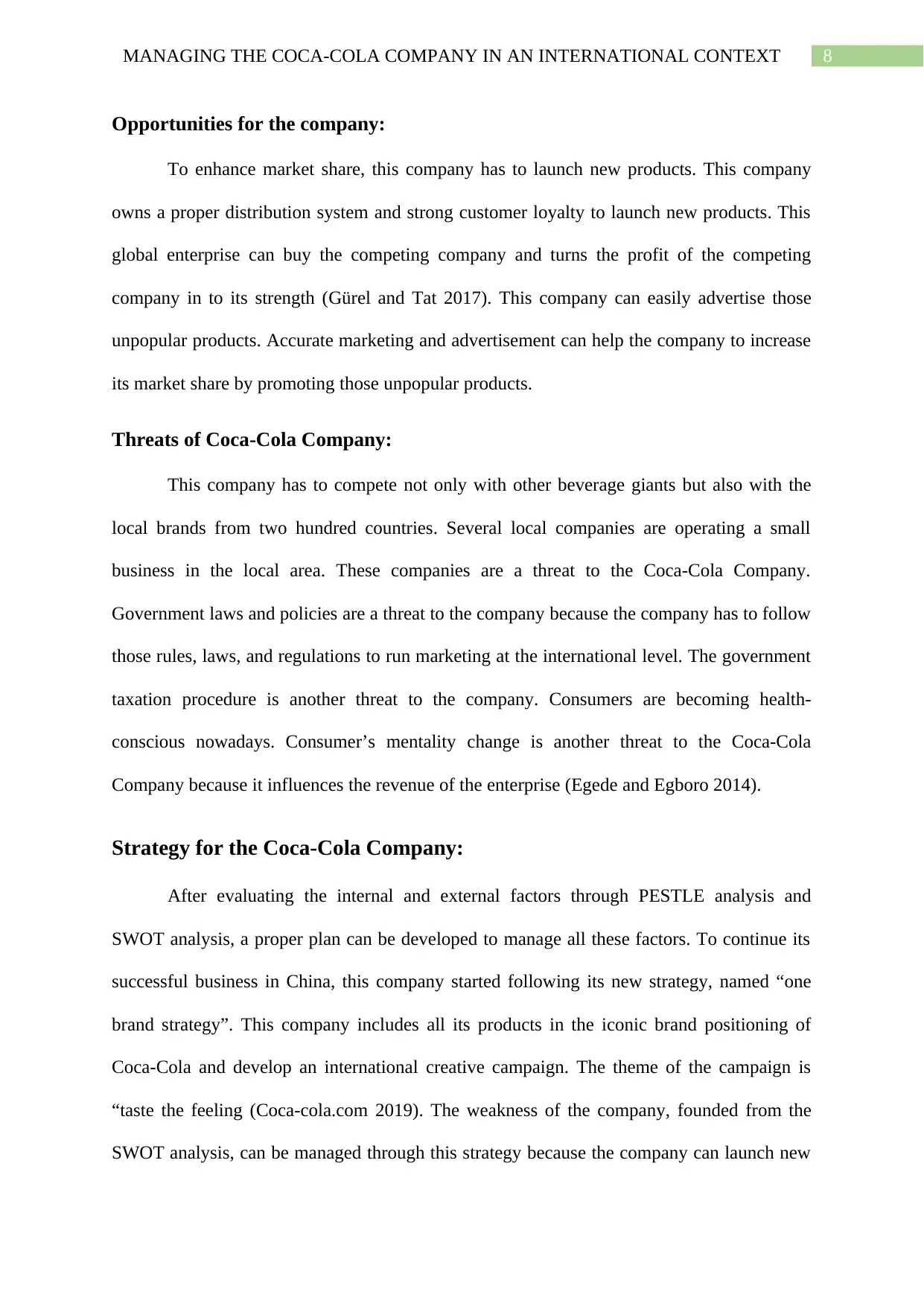
8MANAGING THE COCA-COLA COMPANY IN AN INTERNATIONAL CONTEXT
Opportunities for the company:
To enhance market share, this company has to launch new products. This company
owns a proper distribution system and strong customer loyalty to launch new products. This
global enterprise can buy the competing company and turns the profit of the competing
company in to its strength (Gürel and Tat 2017). This company can easily advertise those
unpopular products. Accurate marketing and advertisement can help the company to increase
its market share by promoting those unpopular products.
Threats of Coca-Cola Company:
This company has to compete not only with other beverage giants but also with the
local brands from two hundred countries. Several local companies are operating a small
business in the local area. These companies are a threat to the Coca-Cola Company.
Government laws and policies are a threat to the company because the company has to follow
those rules, laws, and regulations to run marketing at the international level. The government
taxation procedure is another threat to the company. Consumers are becoming health-
conscious nowadays. Consumer’s mentality change is another threat to the Coca-Cola
Company because it influences the revenue of the enterprise (Egede and Egboro 2014).
Strategy for the Coca-Cola Company:
After evaluating the internal and external factors through PESTLE analysis and
SWOT analysis, a proper plan can be developed to manage all these factors. To continue its
successful business in China, this company started following its new strategy, named “one
brand strategy”. This company includes all its products in the iconic brand positioning of
Coca-Cola and develop an international creative campaign. The theme of the campaign is
“taste the feeling (Coca-cola.com 2019). The weakness of the company, founded from the
SWOT analysis, can be managed through this strategy because the company can launch new
Opportunities for the company:
To enhance market share, this company has to launch new products. This company
owns a proper distribution system and strong customer loyalty to launch new products. This
global enterprise can buy the competing company and turns the profit of the competing
company in to its strength (Gürel and Tat 2017). This company can easily advertise those
unpopular products. Accurate marketing and advertisement can help the company to increase
its market share by promoting those unpopular products.
Threats of Coca-Cola Company:
This company has to compete not only with other beverage giants but also with the
local brands from two hundred countries. Several local companies are operating a small
business in the local area. These companies are a threat to the Coca-Cola Company.
Government laws and policies are a threat to the company because the company has to follow
those rules, laws, and regulations to run marketing at the international level. The government
taxation procedure is another threat to the company. Consumers are becoming health-
conscious nowadays. Consumer’s mentality change is another threat to the Coca-Cola
Company because it influences the revenue of the enterprise (Egede and Egboro 2014).
Strategy for the Coca-Cola Company:
After evaluating the internal and external factors through PESTLE analysis and
SWOT analysis, a proper plan can be developed to manage all these factors. To continue its
successful business in China, this company started following its new strategy, named “one
brand strategy”. This company includes all its products in the iconic brand positioning of
Coca-Cola and develop an international creative campaign. The theme of the campaign is
“taste the feeling (Coca-cola.com 2019). The weakness of the company, founded from the
SWOT analysis, can be managed through this strategy because the company can launch new
⊘ This is a preview!⊘
Do you want full access?
Subscribe today to unlock all pages.

Trusted by 1+ million students worldwide
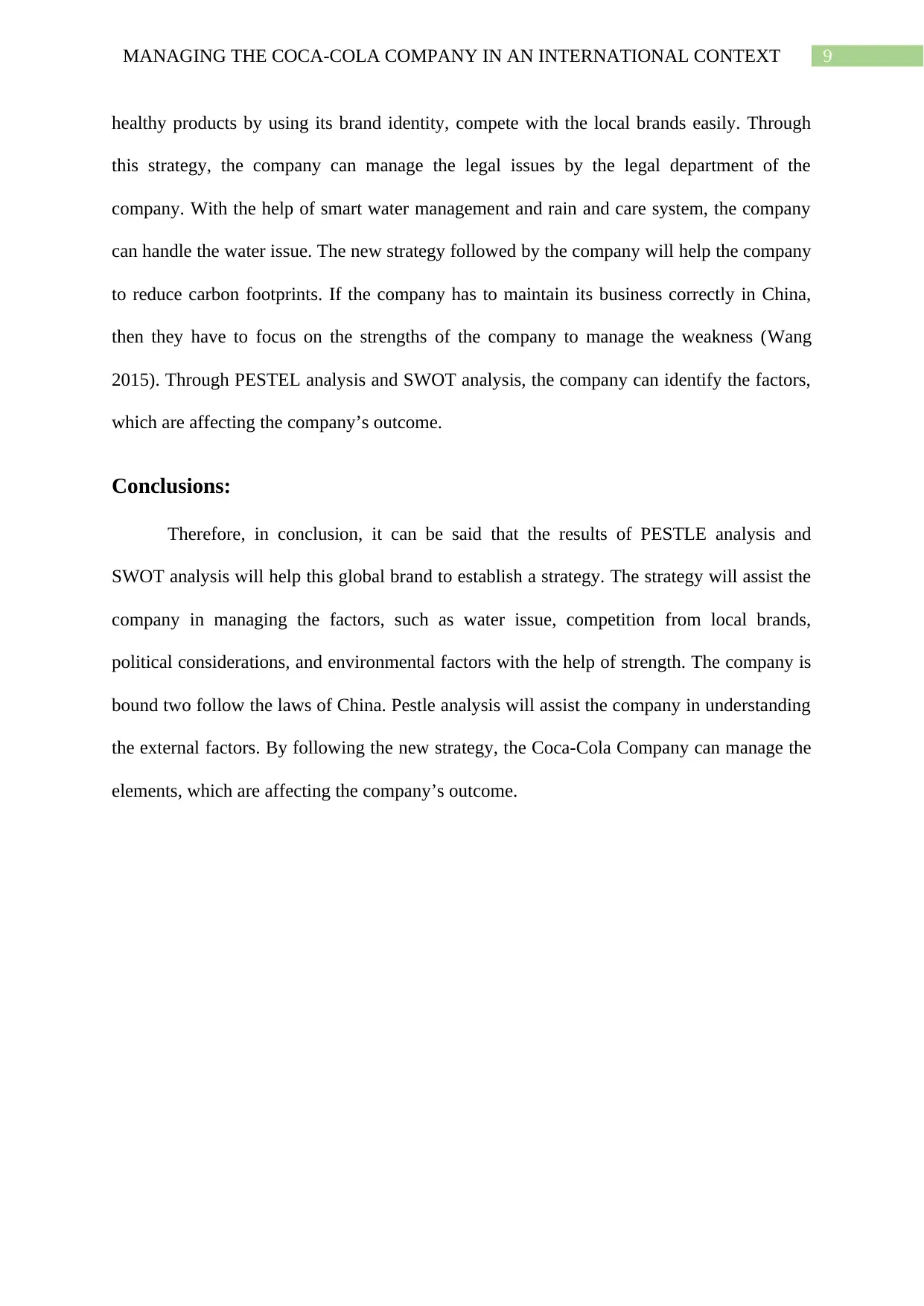
9MANAGING THE COCA-COLA COMPANY IN AN INTERNATIONAL CONTEXT
healthy products by using its brand identity, compete with the local brands easily. Through
this strategy, the company can manage the legal issues by the legal department of the
company. With the help of smart water management and rain and care system, the company
can handle the water issue. The new strategy followed by the company will help the company
to reduce carbon footprints. If the company has to maintain its business correctly in China,
then they have to focus on the strengths of the company to manage the weakness (Wang
2015). Through PESTEL analysis and SWOT analysis, the company can identify the factors,
which are affecting the company’s outcome.
Conclusions:
Therefore, in conclusion, it can be said that the results of PESTLE analysis and
SWOT analysis will help this global brand to establish a strategy. The strategy will assist the
company in managing the factors, such as water issue, competition from local brands,
political considerations, and environmental factors with the help of strength. The company is
bound two follow the laws of China. Pestle analysis will assist the company in understanding
the external factors. By following the new strategy, the Coca-Cola Company can manage the
elements, which are affecting the company’s outcome.
healthy products by using its brand identity, compete with the local brands easily. Through
this strategy, the company can manage the legal issues by the legal department of the
company. With the help of smart water management and rain and care system, the company
can handle the water issue. The new strategy followed by the company will help the company
to reduce carbon footprints. If the company has to maintain its business correctly in China,
then they have to focus on the strengths of the company to manage the weakness (Wang
2015). Through PESTEL analysis and SWOT analysis, the company can identify the factors,
which are affecting the company’s outcome.
Conclusions:
Therefore, in conclusion, it can be said that the results of PESTLE analysis and
SWOT analysis will help this global brand to establish a strategy. The strategy will assist the
company in managing the factors, such as water issue, competition from local brands,
political considerations, and environmental factors with the help of strength. The company is
bound two follow the laws of China. Pestle analysis will assist the company in understanding
the external factors. By following the new strategy, the Coca-Cola Company can manage the
elements, which are affecting the company’s outcome.
Paraphrase This Document
Need a fresh take? Get an instant paraphrase of this document with our AI Paraphraser
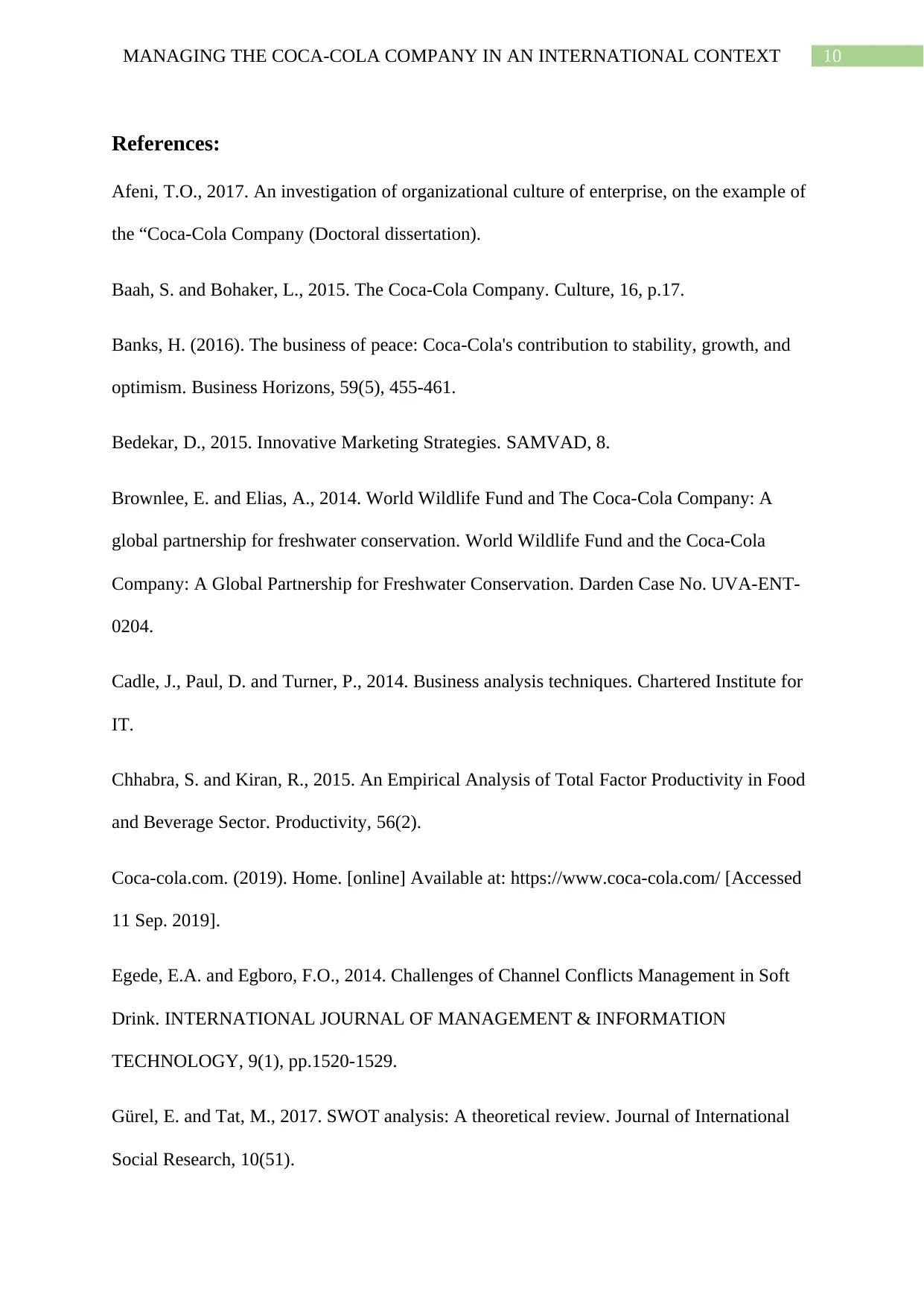
10MANAGING THE COCA-COLA COMPANY IN AN INTERNATIONAL CONTEXT
References:
Afeni, T.O., 2017. An investigation of organizational culture of enterprise, on the example of
the “Coca-Cola Company (Doctoral dissertation).
Baah, S. and Bohaker, L., 2015. The Coca-Cola Company. Culture, 16, p.17.
Banks, H. (2016). The business of peace: Coca-Cola's contribution to stability, growth, and
optimism. Business Horizons, 59(5), 455-461.
Bedekar, D., 2015. Innovative Marketing Strategies. SAMVAD, 8.
Brownlee, E. and Elias, A., 2014. World Wildlife Fund and The Coca-Cola Company: A
global partnership for freshwater conservation. World Wildlife Fund and the Coca-Cola
Company: A Global Partnership for Freshwater Conservation. Darden Case No. UVA-ENT-
0204.
Cadle, J., Paul, D. and Turner, P., 2014. Business analysis techniques. Chartered Institute for
IT.
Chhabra, S. and Kiran, R., 2015. An Empirical Analysis of Total Factor Productivity in Food
and Beverage Sector. Productivity, 56(2).
Coca-cola.com. (2019). Home. [online] Available at: https://www.coca-cola.com/ [Accessed
11 Sep. 2019].
Egede, E.A. and Egboro, F.O., 2014. Challenges of Channel Conflicts Management in Soft
Drink. INTERNATIONAL JOURNAL OF MANAGEMENT & INFORMATION
TECHNOLOGY, 9(1), pp.1520-1529.
Gürel, E. and Tat, M., 2017. SWOT analysis: A theoretical review. Journal of International
Social Research, 10(51).
References:
Afeni, T.O., 2017. An investigation of organizational culture of enterprise, on the example of
the “Coca-Cola Company (Doctoral dissertation).
Baah, S. and Bohaker, L., 2015. The Coca-Cola Company. Culture, 16, p.17.
Banks, H. (2016). The business of peace: Coca-Cola's contribution to stability, growth, and
optimism. Business Horizons, 59(5), 455-461.
Bedekar, D., 2015. Innovative Marketing Strategies. SAMVAD, 8.
Brownlee, E. and Elias, A., 2014. World Wildlife Fund and The Coca-Cola Company: A
global partnership for freshwater conservation. World Wildlife Fund and the Coca-Cola
Company: A Global Partnership for Freshwater Conservation. Darden Case No. UVA-ENT-
0204.
Cadle, J., Paul, D. and Turner, P., 2014. Business analysis techniques. Chartered Institute for
IT.
Chhabra, S. and Kiran, R., 2015. An Empirical Analysis of Total Factor Productivity in Food
and Beverage Sector. Productivity, 56(2).
Coca-cola.com. (2019). Home. [online] Available at: https://www.coca-cola.com/ [Accessed
11 Sep. 2019].
Egede, E.A. and Egboro, F.O., 2014. Challenges of Channel Conflicts Management in Soft
Drink. INTERNATIONAL JOURNAL OF MANAGEMENT & INFORMATION
TECHNOLOGY, 9(1), pp.1520-1529.
Gürel, E. and Tat, M., 2017. SWOT analysis: A theoretical review. Journal of International
Social Research, 10(51).
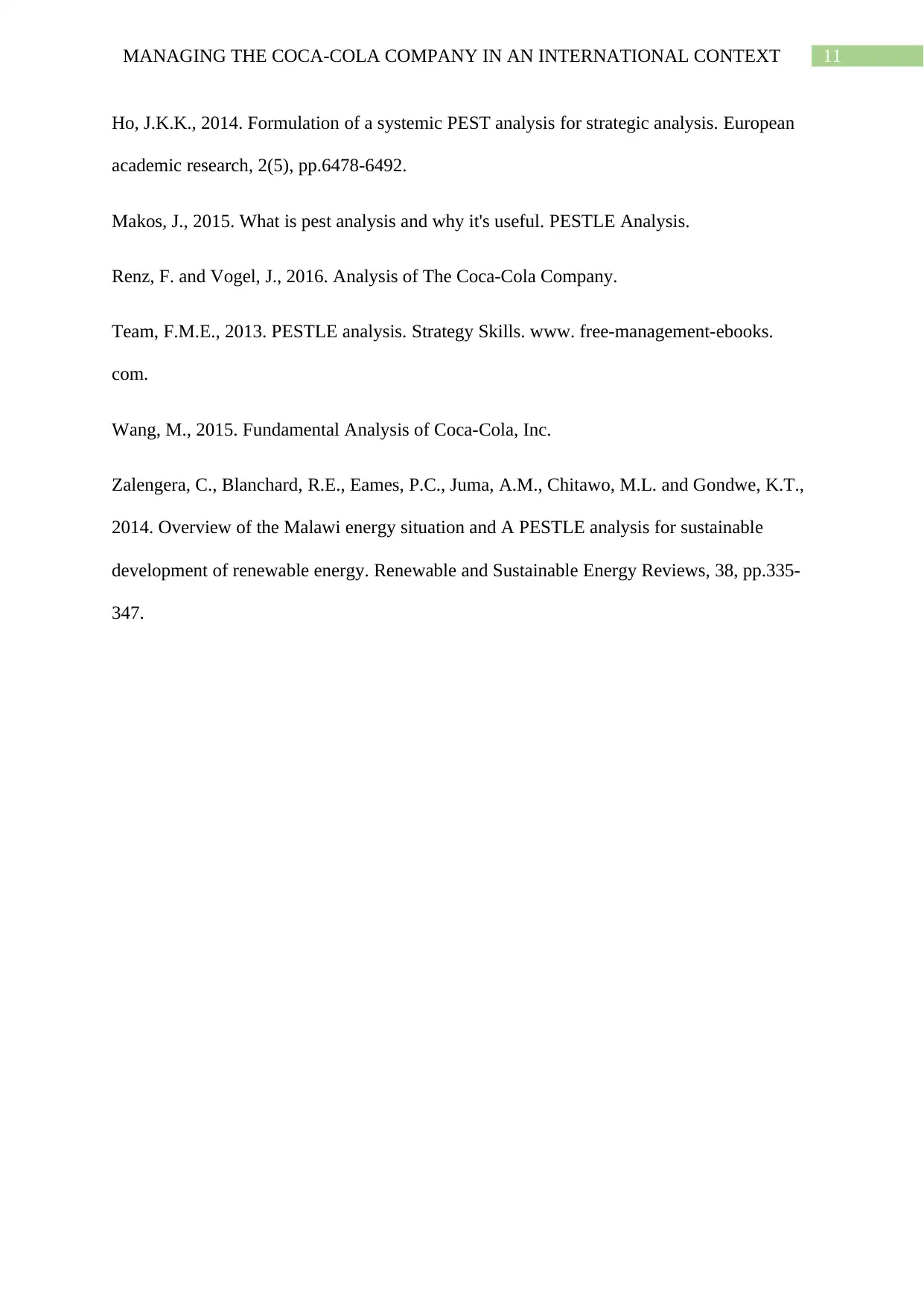
11MANAGING THE COCA-COLA COMPANY IN AN INTERNATIONAL CONTEXT
Ho, J.K.K., 2014. Formulation of a systemic PEST analysis for strategic analysis. European
academic research, 2(5), pp.6478-6492.
Makos, J., 2015. What is pest analysis and why it's useful. PESTLE Analysis.
Renz, F. and Vogel, J., 2016. Analysis of The Coca-Cola Company.
Team, F.M.E., 2013. PESTLE analysis. Strategy Skills. www. free-management-ebooks.
com.
Wang, M., 2015. Fundamental Analysis of Coca-Cola, Inc.
Zalengera, C., Blanchard, R.E., Eames, P.C., Juma, A.M., Chitawo, M.L. and Gondwe, K.T.,
2014. Overview of the Malawi energy situation and A PESTLE analysis for sustainable
development of renewable energy. Renewable and Sustainable Energy Reviews, 38, pp.335-
347.
Ho, J.K.K., 2014. Formulation of a systemic PEST analysis for strategic analysis. European
academic research, 2(5), pp.6478-6492.
Makos, J., 2015. What is pest analysis and why it's useful. PESTLE Analysis.
Renz, F. and Vogel, J., 2016. Analysis of The Coca-Cola Company.
Team, F.M.E., 2013. PESTLE analysis. Strategy Skills. www. free-management-ebooks.
com.
Wang, M., 2015. Fundamental Analysis of Coca-Cola, Inc.
Zalengera, C., Blanchard, R.E., Eames, P.C., Juma, A.M., Chitawo, M.L. and Gondwe, K.T.,
2014. Overview of the Malawi energy situation and A PESTLE analysis for sustainable
development of renewable energy. Renewable and Sustainable Energy Reviews, 38, pp.335-
347.
⊘ This is a preview!⊘
Do you want full access?
Subscribe today to unlock all pages.

Trusted by 1+ million students worldwide
1 out of 12
Related Documents
Your All-in-One AI-Powered Toolkit for Academic Success.
+13062052269
info@desklib.com
Available 24*7 on WhatsApp / Email
![[object Object]](/_next/static/media/star-bottom.7253800d.svg)
Unlock your academic potential
Copyright © 2020–2025 A2Z Services. All Rights Reserved. Developed and managed by ZUCOL.





